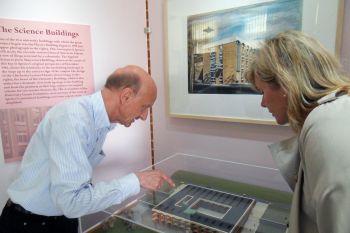Spence exhibition celebrates University’s architectural heritage
Posted on behalf of: University of Sussex
Last updated: Friday, 11 May 2012

Basil Spence exhibition 2012 - Professor Maurice Howard and visitor
What does an architect do after rebuilding a great English cathedral?
In the case of Sir Basil Spence (1907-76), one of the most eminent Modern architects of the post-war period, it was to design the first of a new wave of universities: the University of Sussex.
This year, the University celebrates its 50th anniversary alongside Spence’s Coventry Cathedral.
To mark Spence’s enduring contribution to Sussex and evoke a sense of the early years, art historian Professor Maurice Howard - assisted by Art History graduates Sally Johnson and Mike Davy - has brought together for the first time the University’s own collection of original drawings (some by Spence), models, photographs and artifacts.
Spence’s modernist vision for a university fit for a brave new world required a bold, innovative concept, but the architect was also sensitive to the beauty of the Downland setting and the value of local, traditional building materials.
Spence said at the time: “Bricks and mortar can provide a background that is sympathetic to young and energetic minds which are growing and developing apace.”
The resulting buildings - including Falmer House, the Library, the Arts buildings, the Gardner Arts Centre (now the Attenborough Centre for the Creative Arts), Chichester I and Pevensey I - remain at the heart of campus today and became the first 1960s buildings in the country to be listed. (Falmer House, in fact, shares Grade I listed status with Coventry Cathedral). Spence’s practice designed 17 buildings in all for the University.
The exhibition, which opens on Thursday (10 May) and runs until 14 June, explores the phases of development, public and press reaction to the scheme, the early use of the buildings and the landscaping of the environs, as well as the buildings’ place in Spence’s distinguished career.
The exhibition space (Arts A108) overlooks Library Square and the core campus buildings, which brings the final results of the first phase of building into sharp focus.
Original research by Professor Howard and by the country’s leading Spence scholar, Sussex alumna Dr Louise Campbell, brings out the significance of the buildings, while Spence himself will be seen giving his views in archive film as part of the visitor experience.
Professor Howard says: “I have been involved in many exhibitions for national museums and learned societies, but the chance to work on this show about the historic legacy of buildings at my own university has been an extraordinary experience.
“Working with a team of professional designers has meant that the exhibition looks very beautiful, the objects present a strong sense of artistic merit and yet it is clear they served as the practical means of planning the University’s listed buildings.
“To bring all this together has meant consultation with the country’s leading scholars of Basil Spence, his family and business associates, but also people who knew the University in its early days.
“I hope that the exhibition will elicit more memories and information since I see this very much as the starting-point of the next stage of valuing the University’s buildings and planning their future.”
The exhibition is open Monday-Saturday (closed bank holidays), 10.30am–5.30pm, in Arts A108.
The exhibition is partnered by a lecture given by Dr Campbell (now at the University of Warwick) and introduced by the architect Anthony Blee (son-in-law and practice partner of Sir Basil Spence), on Spence, Sussex and the Sixties, on Wednesday 23 May.
Professor Howard will also give ‘Meet the Curator’ talks in the exhibition on Monday 14 May (at 1pm), Tuesday 29 May (1pm), and Thursday 7 June (1pm and 4pm). Just turn up.

